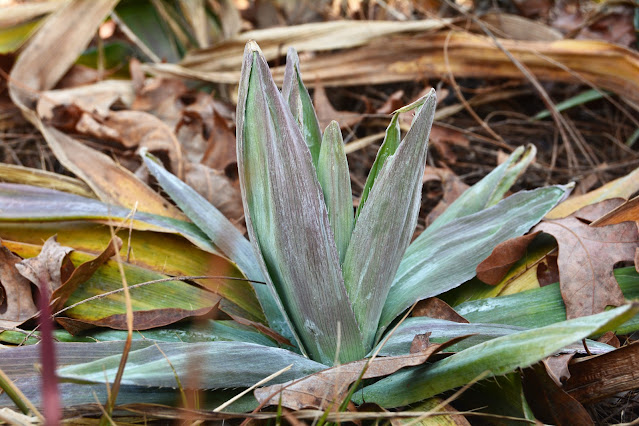Herbaceous Perennials with Purple Color in Winter
 |
| coral bells (Heuchera 'Lime Marmelade') |
Winter weather in North Georgia can fluctuate wildly from mild 50+ degrees to downright frigid, below freezing temperatures. We also receive a lot of rainfall from December though February. The changes in temperature, reduced sunshine hours and moisture availability affects the herbaceous perennials that maintain their leaves through the winter months.
 |
| common spiderwort (Tradescantia ohiensis) |
 |
| golden alexander (Zizia aurea) |
We all learned back in school that photosynthesis is light energy that is transformed into chemical energy. The pigment molecules in plant leaves absorb visible light and create the green color we see on leaves during the growing season. The different concentrations of the various pigments dictate the color of green we see [mossy green, lime green, or fern green].
 |
| rattlesnake master (Eryngium yuccifolium) |
As photosynthesis slows, other leaf pigments become apparent. When temperatures drop below 45 degrees, leaves produce more sugar and close their veins to prevent the sugar from moving, producing more intense colors. Under reduced light conditions, [shorter days and often cloudy/rainy days in winter] the color intensity decreases because the plant is limiting the sugars available for anthocyanin production.
 |
| green and gold (Chrysogonum virginianum) |
Some plants have naturally occurring
purple leaves, thought to protect against sun damage or to hide from insects
and herbivores* that are attracted to green foliage. Understory plants often
have purple undersides, like the crane fly orchid (Tipularia discolor). In woodland settings the sun's rays
are a coveted commodity and plants want to use what they get. The presence of
chlorophyll b, which absorbs blue light, helps convert a wider range of the
energy from the sun into chemical energy.
*Fun Fact: plants with high levels of anthocyanin often occur with high concentrations of poisonous phenois, which may indicate that the purple leaves ward off herbivores.
|
See my Wildflower Wednesday post for more
on Tipularia discolor. |
Interestingly,
plants that receive too much sunlight can suffer from photoinhibition,
preventing the plant to carry out photosynthesis. So when it comes to plants
there is a fine balance between too much and too little light.
Purple leaves are caused by a pigment called anthocyanin, which absorbs green and yellow light, causing them to appear purple. These leaves still contain chlorophyll but the green color is masked by the higher concentration of anthocyanin.
 |
| stokes aster (Stokes laevis) |
 |
| oakleaf hydrangea (hydrangea quercifolia) |

.png)
